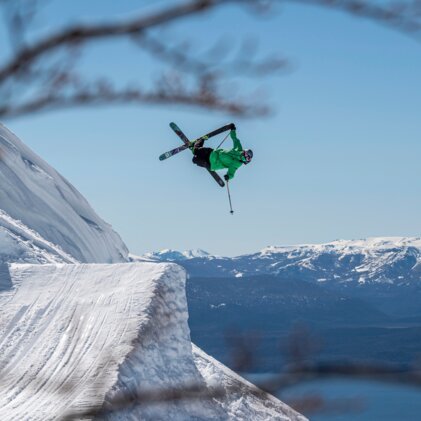
Flip, switch, loop, mute … No, we’re not talking about a DJ set on a radio show. These are all terms used in freestyle skiing. But if you’re a die-hard freestyle enthusiast, you probably already knew this! What you might not know is how to choose the right length for freestyle skis …
Getting a grip on the seemingly endless options for freestyle ski setups can be a bit tricky – maybe even trickier than getting your freestyle lingo right. But don’t worry – we have you covered! INTERSPORT Rent got together with the experts at Völkl to give you the low-down on how to choose the perfect ski size.
One thing up front: Finding the right length is a highly individual matter and mostly depends on what you intend to do with your skis.
What to consider when deciding on the length of your freestyle skis
When picking out skis, you first need to think about the following – as this will help you get the most out of your setup:
- your preferred “playground” (park, pipe, off-piste, all-mountain)
- height
- weight
- riding style
As a general rule of thumb: Taller and heavier skiers need longer skis – but as we’ve already mentioned, there’s more to the equation than just height and weight!
Getting started
The pros and cons of shorter and longer skis
To give you an overview of how length affects the riding behaviour of your skis, we’ve summarised the most important pros and cons. This will help you quickly determine which pair to grab during your next trip to the shop. For more in-depth information on the right skis for your preferred terrain, keep reading – we’ll touch on that further down below!
Shorter skis …
- … are good for: aerial tricks, spinning on rails, high-manoeuvre stunts.
- … are better for quick, sharp turns.
- … are easier to spin and control.
- … don’t go as fast or float in powder as easily.
Longer skis …
- … are good for: big jumps, pipes, off-piste.
- … go faster and float better.
- … are great for getting more air on big jumps.
- … turn and spin slower.
Sizing guide based on your preferred terrain
Park, pipe or natural features in the backcountry: What’s your “playground of choice”? Depending on the type of terrain you’re most keen on, you should opt for slightly longer or shorter skis.
Park & pipe
Terrain: groomed and hard packed
Option 1 – Jibs
If you’re planning to do a lot of jibbing, opt for playful, nimble skis that are easy to manoeuvre through turns, across boxes and that spin easily on rails. Slightly shorter skis (relative to all-mountain skis) with a length between your chin and nose will do the trick for you. A shorter length gives you more control of your skis, increases manoeuvrability, and lessens the swing weight during spins and flips.
- Other characteristics the ski should have: soft flex, tip and tail rocker, semi-wide
- Our top pick: Völkl’s Revolt 86 or Revolt 90
Option 2 – Jumps
Going big usually also means going fast. Now, how do you do that? Generally, with slightly longer skis. Opt for typical all-mountain ski length or skis that are about as long as you are tall. This will give you more grip and stability at speed and on landings. But: Don’t go too long or you’ll experience excessive swing weight during aerial tricks.
- Other characteristics the ski should have: stiff flex, camber, narrow to average width
- Our top pick: Völkl’s Revolt 90 or Revolt 84
Option 3 – A bit of both
If both pipe and park skiing are in your repertoire, go by your personal preference and what we’ve just explained. Shorter skis will be easier to manoeuvre, longer skis give you more stability …
- Other characteristics the ski should have: moderate flex, hybrid rocker, average to semi-wide
- Our top pick: Völkl’s Revolt 95
Natural freestyle terrain (off-piste)
Terrain: soft powder snow, logs, stumps, cliffs, rocks
Freestyling in off-piste terrain is certainly the most specific and rarest type of use for a freestyle ski – but let’s still touch on it quickly: If you’re planning to hit the mountain’s natural features, you should opt for a wide and playful ski that allows you to land tricks in deep powder snow. Getting skis that are longer than traditional freestyle skis will help you stay afloat. We recommend a ski that’s your height or about 5 to 15 cm taller than you (for a good skier).
- Our top pick: Völkl’s Revolt 95
Let’s be honest: In reality, hardly anyone uses a freestyle ski to hit the backcountry and the other way around. In the park, the edges need to be smooth, and going into the park with a freeride ski practically destroys the edges. Backcountry skis are usually also wider, heavier and feature an extreme rocker profile. All not ideal for park skiing. So: Get (or rent!) a park ski if you want to hit the park – otherwise, opt for a freeride ski!
All-mountain
Terrain: groomed, mix of piste and park
If you want a ski that’s as versatile as can be, go for a length of about 5 cm shorter than your height, i.e. a ski that ends between your nose and your forehead. This way, you’ll only lose a little manoeuvrability and a little top speed – but your skis will be suitable for almost any terrain.
- Other characteristics the ski should have: hybrid camber, tip and tail rocker
- Our top pick: Völkl’s 104
INTERSPORT Rent tip
There’s no one-size-fits-all freestyle ski. If you really want to get the most out of your day in the park or on the pipe, just drop by one of our INTERSPORT Rent shops. Our RENTertainers on site will help you pick the perfect gear for freestyling – including the right size skis for your requirements.
What’s more, they just might tell you where to find the best natural and man-made features in the entire resort. Happy jibbing and jumping!







